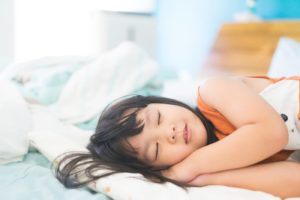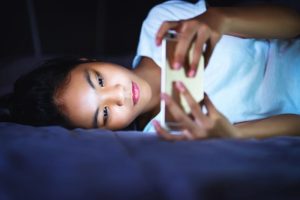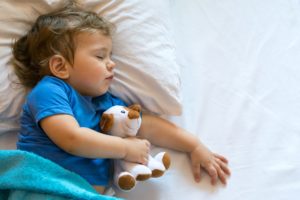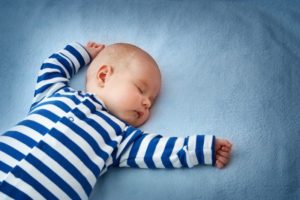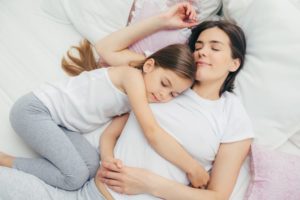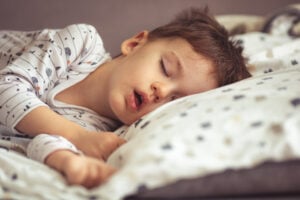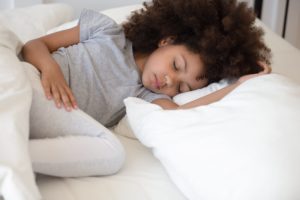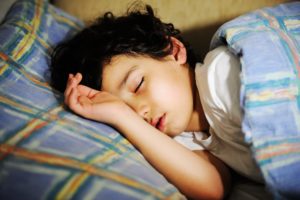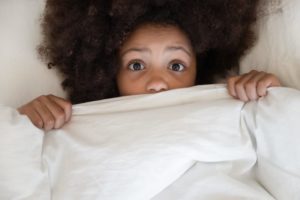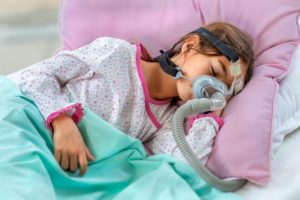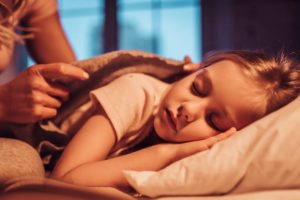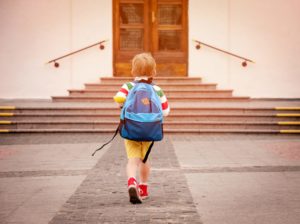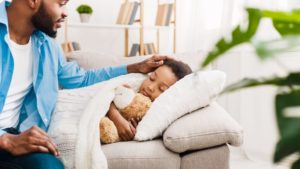Sleep Disorders in Children
Getting plenty of sleep is crucial to the health and development of a young child, but nearly half of children experience sleep issues at some point in their childhood. Common sleep disorders in children include sleep apnea and insomnia, as well as parasomnias, which are disruptive sleep-related behaviors such as sleepwalking and night terrors.
Sleep disorders in children, especially parasomnias, are not likely to persist past adolescence. However, they can be disruptive to a child’s daytime behavior and overall quality of life. We discuss the causes of sleep disorders in children, common symptoms, tips for helping children cope with sleep problems, and when to see a doctor.
What Causes Sleep Disorders in Children?
Certain sleep disorders have similar causes in both adults and children. Obesity is a leading risk factor for developing obstructive sleep apnea , a sleep-related breathing disorder, in people of all ages. Additionally, sleep disorders that may have a genetic predisposition, such as restless legs syndrome, affect children as well as adults. Certain medical issues and anxiety disorders increase risk for sleep issues at any age.
However, behavioral patterns that are unique to children can also lead to sleep-related disorders. Up to about age 5, insomnia is usually the result of inconsistent bedtimes and bedtime-resistant behaviors.
Insomnia
Insomnia is one of the most common sleep disorders and affects 20% to 30% of children. The primary symptoms are trouble falling asleep, staying asleep, or both.
Medical experts usually divide insomnia in children into three categories.
- Behavioral insomnia: Most common in children up to 5 years old, this form of insomnia is associated with resistance to sleep, taking a long time to fall asleep, and frequent nighttime wakings. These behaviors happen on occasion with most children, but may be considered a sleep disorder if they occur frequently and persistently and interfere with their normal functioning.
- Conditioned insomnia: More common in older children and adolescents, conditioned insomnia occurs when feelings of anxiety related to bedtime and sleep prevent the child from falling asleep or staying asleep.
- Transient sleep disturbances: Temporary disruptions in a child’s normal routine such as traveling, illness, or stressful life events can cause short-term bouts of insomnia.
Childhood insomnia can be challenging for the whole family. However, effective treatments are available. Behavioral changes such as establishing a consistent bedtime routine are typically the first line of treatment and can lead to improvements in well-being for both the child and their caregivers.
Obstructive Sleep Apnea
Obstructive sleep apnea (OSA) occurs when the tissues in the throat block the passage of air during sleep. This can lead to frequent, momentary lapses in breathing that can significantly disturb nightly sleep.
Approximately 1% to 5% of children experience obstructive sleep apnea. In children, common causes include enlarged tonsils, obesity, and certain dental conditions or birth defects.
Depending on the severity of symptoms and other risk factors such as obesity, a pediatrician may recommend further evaluation by either a specialist in sleep medicine or through a sleep study, which involves overnight medical analysis at a sleep clinic.
Treatment options depend on the cause and severity of OSA in children, but may include continuous positive airway pressure (CPAP) therapy or wearing a mouthguard at night. If it is determined that the cause is enlarged tonsils or adenoids, surgery to remove them may be recommended.
Snoring in Children
The majority of children with sleep apnea also experience snoring. Keep in mind that snoring in children is relatively common and does not always indicate a larger issue. Between 10% and 17% of children snore and may not show other signs of sleep apnea. Parents or caregivers of a child who snores loudly or frequently should discuss their symptoms with a pediatrician. A pediatrician may recommend a sleep study to further evaluate the child’s snoring and sleep.
Sleepwalking
Sleepwalking, also known as somnambulism, is a disorder that involves walking or engaging in other complex behaviors while asleep.
Sleepwalking tends to be more common in children than adults. Approximately 5% of children exhibit signs of sleepwalking compared with 1.5% of adults. Safety precautions and harm reduction are important steps in managing sleepwalking in children.
It is important to speak with a pediatrician if symptoms of sleepwalking are frequent and persistent. A doctor can rule out any serious underlying causes and help develop an effective treatment plan. Similar to bedwetting, sleepwalking tends to resolve as the child grows older.
Night Terrors
Night terrors are a type of parasomnia where the sleeper suddenly awakens feeling frightened and panicked. The sleeper usually has no memory of the frightening event.
Night terrors are rare in adults. However, about 30% of children experience night terrors, usually between the ages of 3 and 7. Medical researchers do not completely understand why night terrors occur, although a familial predisposition has been observed.
Treatment options are limited. The best thing to do is provide comfort and reassurance after a night terror episode. If you decide to consult a pediatrician about your child’s night terrors, it may be helpful to keep a sleep diary on the frequency and duration of episodes.
Nightmares in Children
It is important to make a distinction between night terrors and nightmares in children. Night terrors are a sleep disorder that typically occurs during the non-rapid eye movement (NREM) stage of sleep. The child will typically have no memory of the episode.
In contrast, nightmares more commonly occur during rapid eye movement (REM) sleep, the sleep stage usually associated with dreaming . Nightmares are often brought on by stress or major life events. Bad dreams can also cause feelings of anxiety, which the child may want to talk through with a parent or a caregiver.
Excessive Daytime Sleepiness
Excessive daytime sleepiness is associated with reduced alertness, increased sleepiness, and falling asleep during the day. While not a disorder in itself, excessive daytime sleepiness is a common symptom that is associated with a number of sleep-related issues and health conditions.
Between 10% and 20% of children experience signs of daytime sleepiness. However, it may be underdiagnosed in some children. One reason is that the secondary symptoms in children can seem contradictory, including hyperactivity, fidgeting, and aggressive behavior.
If your child is experiencing noticeable sleepiness during the day or changes in their behavior, consult with their pediatrician. There are several screening methods for pediatric sleep issues that can help identify sleep-related problems.
Bruxism
Bruxism refers to repetitive teeth grinding. In adolescents, the prevalence of sleep bruxism is estimated to be around 15% .
Teeth grinding can occur during the day or the night. When it occurs at night, it can disrupt a child’s sleep. Teeth grinding can also lead to a number of painful symptoms including headaches, tooth damage, and injury to the jaw muscles.
Teeth grinding in children and adults can be due to multiple factors, making it difficult to identify a single cause in individuals. However, stress has been found to be closely associated with bruxism . Sleep bruxism may lessen as a child ages, but the condition can also be recurring. Treatment options include mouthguards to prevent damage to the teeth and the use of psychotherapy and relaxation techniques to reduce stress and muscle tension.
Restless Legs Syndrome
Restless legs syndrome, also known as Willis-Ekbom disease, is a movement disorder that can significantly disturb sleep. RLS affects 2 to 4% of children in the U.S. although people of all ages can develop RLS. The main symptom is a painless but overwhelming urge to move one’s legs. This urge often increases at night when the person is at rest.
Restless legs syndrome may be caused by an underlying issue such as iron deficiency . In certain cases, the cause may be genetic.
Symptoms can appear in childhood, but this disorder is largely underdiagnosed in children. If your child is experiencing an uncontrollable urge to move their legs that gets worse at night and disrupts their sleep, consult with a medical professional. With a proper diagnosis, symptoms can be treated.
Tips for Helping a Child With Sleep Problems
If a child is experiencing frequent issues related to bedtime and sleep, there are several approaches parents and caregivers can take.
- Improving sleep hygiene: Sleep hygiene refers to the collective habits and routines that can influence sleep. For young children, a consistent bedtime routine promotes healthy sleep and other positive outcomes such as language development and family bonding. Other important components of proper sleep hygiene include getting daily exercise and limiting screen time in the evening.
- Reducing stressors: Children and teens experiencing mental health issues are more likely to also experience sleep problems. Even if a child does not have a diagnosed mental health issue, stress can have a major impact on sleep in some individuals. Mindfulness meditation techniques can be an effective way to help reduce anxiety for children experiencing stress-related sleep issues.
- Optimizing the sleep environment: A child’s sleep space should help promote relaxation around bedtime. This means minimizing noises, keeping the lights dimmed before bedtime, and controlling the temperature so it is not too hot or too cold.
When to Talk to a Doctor
An occasional night or two of poor sleep is normal for most children. However, constant sleep disturbances or unusual symptoms that frequently prevent a good night’s sleep are generally a cause for concern. If your child is experiencing signs of chronic sleep loss or other pervasive sleep disturbances, discuss their symptoms with their pediatrician or pediatric sleep expert. Depending on their symptoms and medical history, their doctor may recommend an overnight sleep study at a sleep clinic or additional evaluation by a sleep medicine specialist.
References
10 Sources
-
Strohl, K. P. (2022, October). Sleep apnea. Merck Manual Consumer Version.
https://www.merckmanuals.com/home/lung-and-airway-disorders/sleep-apnea/sleep-apnea -
Schwab, R. J. (2022, May). Insomnia and excessive daytime sleepiness (EDS). Merck Manual Consumer Version.
https://www.merckmanuals.com/home/brain,-spinal-cord,-and-nerve-disorders/sleep-disorders/insomnia-and-excessive-daytime-sleepiness-eds -
Paruthi, S. (2022, April 15). Evaluation of suspected obstructive sleep apnea in children. In R. D. Chervin. (Ed.). UpToDate.
https://www.uptodate.com/contents/evaluation-of-suspected-obstructive-sleep-apnea-in-children -
Tapia, I. E., & Wise, M. S. (2022, May 26). Assessment of sleep disorders in children. In R. D. Chervin (Ed.). UpToDate.
https://www.uptodate.com/contents/assessment-of-sleep-disorders-in-children -
Stallman, H. M., & Kohler, M. (2016). Prevalence of Sleepwalking: A Systematic Review and Meta-Analysis. PloS one, 11(11), e0164769.
https://pubmed.ncbi.nlm.nih.gov/27832078/ -
Patel, A. K., Reddy, V., & Araujo, J. F. (2020). Physiology, sleep stages. In StatPearls. StatPearls Publishing.
https://www.ncbi.nlm.nih.gov/books/NBK526132/ -
Prado I.M., Abreu L.G., Silveira K.S., Auad S.M., Paiva S.M., Manfredini D., Serra-Negra J.M. (2018). Study of associated factors with probable sleep bruxism among adolescents. Journal of Clinical Sleep Medicine, 14(8), 1369-1376.
https://pubmed.ncbi.nlm.nih.gov/30092895/ -
Wieckiewicz, M., Paradowska-Stolarz, A., & Wieckiewicz, W. (2014). Psychosocial aspects of bruxism: The most paramount factor influencing teeth grinding. BioMed Research International, 2014, 1–7.
https://pubmed.ncbi.nlm.nih.gov/25101282/ -
MedlinePlus: National Library of Medicine (US). (2018, May 1). Restless legs syndrome.
https://medlineplus.gov/genetics/condition/restless-legs-syndrome/ -
Mansur, A., Castillo, P. R., Rocha Cabrero, F., & Bokhari, S. (2022, September 21). Restless legs syndrome. In StatPearls. StatPearls Publishing.
https://www.ncbi.nlm.nih.gov/books/NBK430878/


